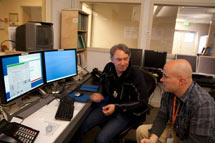
Handy Links
SLAC News Center
SLAC Today
- Subscribe
- Archives: Feb 2006-May 20, 2011
- Archives: May 23, 2011 and later
- Submit Feedback or Story Ideas
- About SLAC Today
SLAC News
Lab News
- Interactions
- Lightsources.org
- ILC NewsLine
- Int'l Science Grid This Week
- Fermilab Today
- Berkeley Lab News
- @brookhaven TODAY
- DOE Pulse
- CERN Courier
- DESY inForm
- US / LHC
SLAC Links
- Emergency
- Safety
- Policy Repository
- Site Entry Form

- Site Maps
- M & O Review
- Computing Status & Calendar
- SLAC Colloquium
- SLACspeak
- SLACspace
- SLAC Logo
- Café Menu
- Flea Market
- Web E-mail
- Marguerite Shuttle
- Discount Commuter Passes
-
Award Reporting Form
- SPIRES
- SciDoc
- Activity Groups
- Library
Stanford
Around the Bay
LCLS Team Puts the 'Ultra' in 'Ultrafast'
As Einstein pointed out, time is relative. For astrophysicists investigating galaxies light years away, a decade is a pinprick on a long continuum. For particle physicists tracing the movement of photons and electrons, a second is an eternity.
For instance, consider the femtosecond. It is one quadrillionth of a second, or one over ten to the power of fifteen. In 100 femtoseconds, a particle moving at the speed of light travels the same distance as the thickness of a single sheet of paper.
The Linac Coherent Light Source at SLAC provides astonishingly bright laser X-rays in 100 femtosecond pulses of photons, emitted by similarly brief bunches of electrons bouncing through the LCLS undulator magnets at nearly the speed of light. For scientists wishing to study molecular structure, the 100 femtosecond pulses make the LCLS a remarkable tool. But for physicists eager to see atoms in motion, 100 femtoseconds is a bit too long. With a few setting changes, last fall the LCLS team achieved pulses as brief as 10 femtoseconds, and scientists hope to make them shorter still.
"These are much shorter pulses than other X-ray sources," said Joe Frisch, part of the accelerator physics group that originated the LCLS approach to achieving short pulses. The idea was to lower the charge in the electron beam, which means fewer electrons are in each bunch.
This gives SLAC scientific users a distinct edge at probing what can happen in these brief, femtosecond windows. Short bunches were a sweet and unexpected surprise for LCLS users during the machine's first user run last fall.
"Every user group wanted to use the new short bunch mode," said Rick Iverson, the LCLS program coordinator. "They were able to do more than they expected. It was a bonus for them."
After the LCLS was up and running with pulses at 100 femtoseconds, scientists decided to try an even shorter mode. First, they modeled the experiment on a computer to see if it would work. When the model did not throw up any red flags, they changed the settings on the LCLS and fired away.
According to indirect measurements and computer simulations, they should be getting around 10 femtosecond bunches, but no one knows for sure. These sub-100 femtosecond pulses are so infinitesimally tiny that current electronic technology is unable to gauge the precise length. Short bunches will force physicists to devise new techniques.
So in distinguishing between two infinitesimally small time frames, what's the advantage of using 10 femtosecond bunches over the original 100?
"The ability to photograph very fast reactions," Frisch explained.
And that's a very appealing idea to a chemist. In the 10 femtosecond and shorter range, the LCLS can capture the movement of atoms, such as the vibration of a single bond between two carbon atoms. In the 5 femtosecond range, scientists can use the laser to knock out multiple electrons within the same molecule.
Ryan Coffee, a physicist with the laser science division, first heard about the accelerator division's success with short pulse last June, and immediately seized the opportunity. In the fall, Coffee and others used the LCLS short bunch mode to knock core electrons from the orbit of nitrogen molecules. Because of their application in energy science, they also want to do the same with carbon and oxygen compounds. Specifically, Coffee wants to knock out the two "1s" electrons, which orbit innermost to the nucleus, like Mercury and Venus in our solar system.
"You can answer a lot of questions if you understand function and structure," he said.
The goal of this project is to tap into energy science. With the LCLS short pulses, researchers can inch closer to understanding how electrons migrate in ever larger molecules, thus grasping at how energy can be captured and used.
Photosynthesis is one reaction that scientists are antsy to glimpse at the fundamental level, because of plants' ability to convert sunlight, water and carbon dioxide into oxygen and sugar—an excellent energy storage molecule. Any photosynthetic protein has a receptor site, or a place where photons are absorbed. Once these photons are absorbed, they provoke a chain of events, such as the protein changing shape. Coffee and his fellow investigators want to understand how, on an atomic level, these shifts occur.
Coffee said the magic range for detecting atom flow is less than ten femtoseconds. "This is the timescale of that first photosynthetic trigger," he said. But this kind of chemistry relies heavily on advancements in accelerator physics to develop, create and fine-tune the equipment capable of capturing the movement of nimble particles.
Enter Yuantao Ding, a SLAC physicist who recently won a five-year grant for related research from the Department of Energy. Ding's award allows him to spend more serious time and money investigating how to shorten the X-ray laser pulses, and also how to improve measurement diagnostics.
Ding is keyed up to explore short bunches further, noting that he needs to carefully plan how to disperse his funding. "I really have to take it seriously to figure out what I can do," he said.
óJulie Karceski
SLAC Today, February 17, 2010
